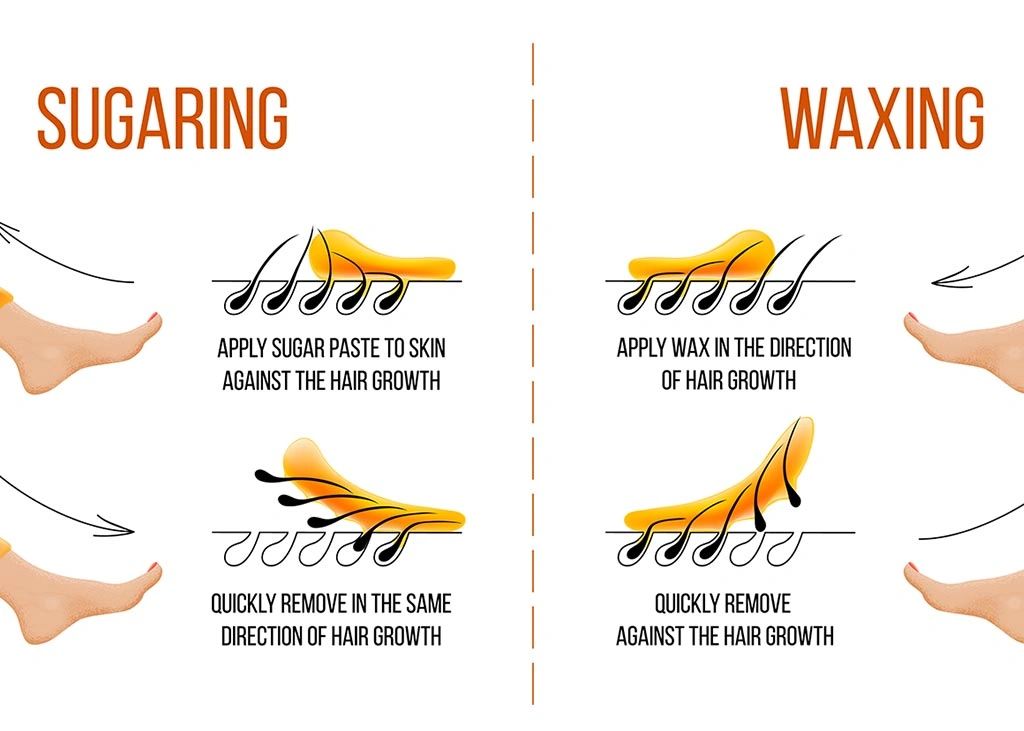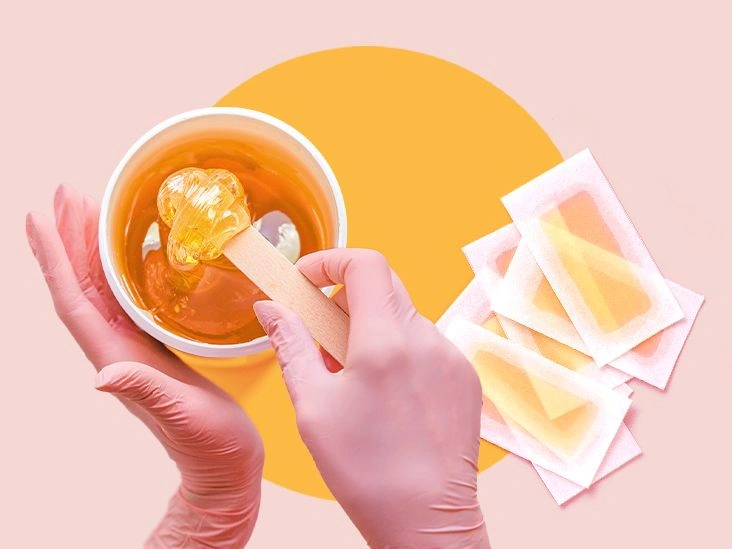What’s the short answer?
Many people confuse sugaring with waxing because both techniques remove hair from the root, unlike shaving which trims hair at the skin’s surface.
Even with these resemblances, a few important distinctions separate sugaring and waxing: primarily the directions of application and removal.
With sugaring, the paste is applied against the direction of hair growth and pulled off in the same direction as the hair grows. With waxing, the wax is spread in the direction of hair growth and removed against it. This difference influences the outcome and feel of each treatment.
Quick comparison chart

What’s in the mixture?
Sugaring paste is crafted from a straightforward blend of lemon, water, and sugar. These components are heated into a candy-like syrup and used warm on the skin.
Wax formulas vary a bit. Hard wax, which is applied and removed once it cools, typically includes beeswax, resin, and oils. Soft wax, which needs cloth or strips for removal, often contains rosin, oils, and additional additives.
Some people prefer sugar pastes because they contain fewer, more transparent ingredients, while waxes can have additives that irritate sensitive skin.
What’s the process like?
The application and removal methods differ considerably between sugaring and waxing.
For sugaring, the cooled paste is smoothed on against the hair growth, then pulled off in the direction the hair grows with quick, small tugs.
Because sugar paste primarily exfoliates the skin surface, it can be reapplied several times to the same spot without much trouble.
Waxing is more regimented. Both hard and soft waxes are spread with the grain of hair growth. After the substance cools and firms, it’s removed against the hair direction.
Because of the removal technique, some waxes can be tougher on skin and may snap shorter hairs rather than extracting them from the root. To reduce this, wax should typically only be applied to the same area once or twice.
Are there any benefits?
Beyond smooth, hair-free skin, both sugaring and waxing provide longer-term advantages.
Both methods act as a form of exfoliation, clearing away dead skin cells while creating smoother skin.
Both remove hair from the root, and with regular upkeep, hair tends to grow back finer and softer.
Lastly, compared with epilators or chemical depilatories, sugaring and hard wax are generally less irritating — even for very sensitive skin.
Are there any side effects or risks to consider?
After either sugaring or waxing, the treated area may be temporarily more sensitive.
Occasionally, you may notice minor redness or bumps, which usually fade in a few days.
Waxing carries a higher chance of ingrown hairs because the wax can lead to hair breakage.
Can you get this if…?
Sugaring and waxing aren’t suitable for everyone, and several situations warrant caution.
You’re on your period
Technically you can still get treated, but you may want to postpone. During menstruation, the skin near your pubic bone can be more sensitive and you may cramp more easily. Both sugaring and waxing can aggravate these sensations, so rescheduling is often preferable.
If you must attend your appointment, most salons request using a tampon or menstrual cup rather than a pad or free flow.
You’re pregnant
This varies. Always consult your physician before sugaring or waxing, especially in the final trimester when sensitivity can increase. If your doctor approves, you can proceed.
Sugaring may be preferable during pregnancy for some people, as it’s often described as less invasive and somewhat less painful than waxing.
You have genital piercings or tattoos
Tattoos can be lightly exfoliated by either sugaring or waxing, helping remove dead skin cells on the surface.
If you have genital piercings, your technician will likely ask you to remove jewelry before treatment. If you can’t, they may not be able to remove hair right next to the piercing.
Is there anyone who shouldn’t get this done?
Your skin may react more strongly to waxing if you’re using:
- certain antibiotics
- hormone replacement therapy
- hormonal birth control
- Accutane
- Retin-A or other topical treatments
Checking with your healthcare provider is wise. In some situations, they may recommend sugaring over waxing because the paste grips hair rather than skin.
Treatments like radiation and chemotherapy can also increase skin sensitivity and dryness, making waxing or sugaring uncomfortable or inadvisable.
How painful is it?
Pain varies based on your tolerance, the method used, and the technician’s skill.
Sugaring paste doesn’t attach strongly to the skin’s top layer; it clings to hair and dead skin cells, which reduces hair breakage and irritation. For that reason, many people find sugaring less painful.
Wax tends to bond to the skin’s surface. Generally, hard wax is less painful than soft wax.
The first session often hurts the most; subsequent appointments can feel much less uncomfortable as hair regrowth patterns change.
How do you find a reputable salon?
Sugaring and waxing are frequently offered in specialist salons focused on one method or the other.
To find a trusted spot, review recent customer feedback carefully, especially comments about cleanliness and professionalism. Ensure the salon follows sanitary practices like wearing gloves and using clean applicators.
Most trustworthy salons will ask you to complete a client questionnaire to assess your needs before treatment.
What should you do before your appointment?
Preparation for sugaring and waxing is essentially the same.
Let your hair grow to about 1/4-inch. This generally takes 10 to 14 days. If hair is longer than 1/2-inch, you may need to trim it beforehand; some technicians will trim for an extra fee.
In the days leading up to your visit, gently exfoliate to remove dead skin and help prevent ingrown hairs.
The day before, avoid exfoliating, tanning, or hot baths, as these can dry or sensitize the skin.
On the day of, arrive with clean, dry skin and avoid lotions or creams. To reduce sensitivity, skip caffeine and alcohol and consider taking an over-the-counter pain reliever about 30 minutes prior.
What happens during the appointment?
Appointments usually run 30 minutes to an hour depending on the area treated. The technician will lead you to a private room, ask you to undress to the necessary level, and lie on the table.
For sugaring, expect the following:
- Once you’re positioned, the technician will cleanse the area and apply a light powder to help hair stand out.
- They’ll press a portion of the paste against the hair growth, then swiftly pull in the direction of hair growth.
- Because sugar paste can be reapplied, it’s possible to make several passes for more precise removal.
- Sugar does not adhere to skin like wax, so cleanup is simple—any residue washes off with water.
For waxing, expect:
- The technician will clean the area and apply a pre-wax product, often oil or powder, to protect the skin.
- They’ll spread a thin coat of wax in the same direction as hair growth.
- Removal is done with paper or cloth strips for soft waxes, or by peeling off the wax itself for hard waxes, pulling against the hair’s direction. This method increases the chance of hair breakage.
- Because wax grips skin, technicians usually only apply it once or twice to any spot to limit irritation.
- After all hair is removed, they’ll calm the area with a serum or lotion to soothe skin and help prevent ingrown hairs.
- If any wax remains, it will be taken off with an oil-based cleanser.
What should you keep in mind immediately after your appointment?
For 24 hours following sugaring or waxing, your skin may be more reactive. Avoid direct sun exposure or tanning, hot baths, further exfoliation, and strenuous exercise, as these can aggravate treated skin.
What can you do to minimize ingrown hairs and other bumps?
You can resume exfoliating about 48 hours after your session. Aim to exfoliate two to three times weekly to reduce the risk of ingrown hairs between visits.
Some people prefer sugaring because it can cleanse hair follicles, removing dead skin and debris that contribute to ingrown hairs.
How long will the results last?
Typically, both sugaring and waxing deliver similar longevity — usually about 3 to 4 weeks, depending on your hair growth rate and color.
With consistent treatments, sessions often become easier and less painful over time. Some people notice reduced hair growth over the long term, though results vary.
The bottom line
Both sugaring and waxing are effective options for longer-lasting hair removal.
There isn’t a definitive “best” choice — preference and skin sensitivity play big roles. Those with delicate skin may lean toward sugaring for its gentler formula and fewer additives.
If you’re uncertain which method to try, read salon reviews, ask friends about their experiences, or book a consultation with the salon you’re considering.


















Leave a Reply
You must be logged in to post a comment.